With the Moon as a spectacular backdrop, an Orbital Sciences’ Cygnus cargo spacecraft speeding at 17500 MPH on a landmark flight and loaded with a huge treasure trove of science, belated Christmas presents and colonies of ants rendezvoued at the space station early this Sunday morning (Jan. 12), captured and then deftly parked by astronauts guiding it with the Canadian robotic arm.
Cygnus is a commercially developed resupply freighter stocked with 1.5 tons of vital research experiments, crew provisions and student science projects that serves as an indispensible “lifeline” to keep the massive orbiting outpost alive and humming with the science for which it was designed.
Following a two day orbital chase that started with the spectacular blastoff on Jan. 9 atop Orbital’s private Antares booster from NASA Wallops Flight Facility, Va., Cygnus fired its on board thrusters multiple times to approach in close proximity to the million pound International Space Station (ISS) by 3 a.m. Sunday.
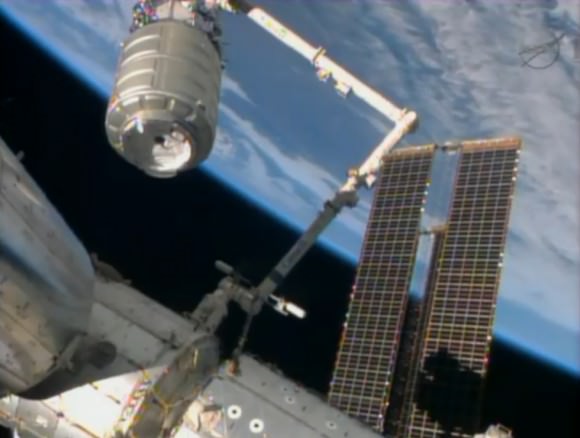
When Cygnus had moved further to within 30 feet (10 meters) NASA Astronaut and station crew member Mike Hopkins – working inside the Cupola – then successfully grappled the ship with the stations 57 foot long Canadarm2 at 6:08 a.m. EST to complete the first phase of today’s operations.
“Capture confirmed,” radioed Hopkins as the complex was flying 258 miles over the Indian Ocean and Madagascar.
“Congratulations to Orbital and the Orbital-1 team and the family of C. Gordon Fullerton,” he added. The ship is named in honor of NASA shuttle astronaut G. Gordon Fullerton who passed away in 2013.
“Capturing a free flyer is one of the most critical operations on the ISS,” explained NASA astronaut and ISS alum Cady Coleman during live NASA TV coverage.
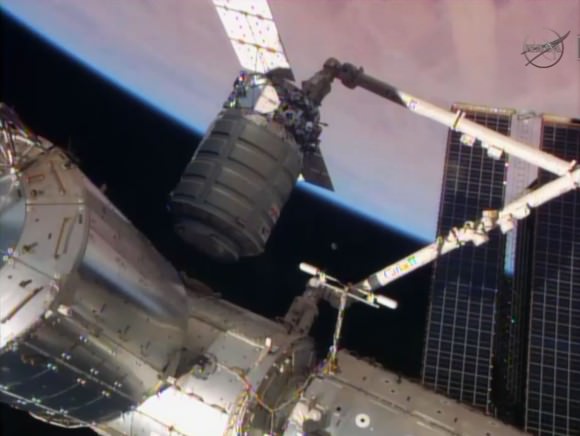
Koichi Wakata of the Japan Aerospace Exploration Agency then took command of the robotic arm and maneuvered Cygnus to berth it at the Earth-facing (nadir) port on the station’s Harmony Node at 8:05 a.m while soaring over Australia.
16 bolts will be driven home and 4 latches tightly hooked to firmly join the two spacecraft together and insure no leaks.
The Orbital -1 spaceship is conducting the first of 8 operational cargo logistics flights scheduled under Orbital Sciences’ multi-year $1.9 Billion Commercial Resupply Services contract (CRS) with NASA that runs through 2016.
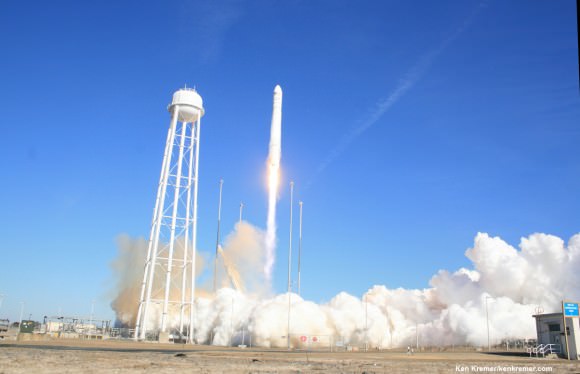
The purpose of the unmanned, private Cygnus spaceship – and the SpaceX Dragon – is to restore America’s cargo to orbit capability that was terminated following the shutdown of NASA’s space shuttles.
Cygnus and Dragon will each deliver 20,000 kg (44,000 pounds) of cargo to the station according to the NASA CRS contracts.
“This cargo operation is the lifeline of the station,” said Coleman.

Cygnus pressurized cargo module – side view – during exclusive visit by Ken Kremer/Universe Today to observe prelaunch processing by Orbital Sciences at NASA Wallops, VA. ISS astronauts will open this hatch to unload 2780 pounds of cargo. Docking mechanism hooks and latches to ISS at left. Credit: Ken Kremer – kenkremer.com
The six person crew of Expedition 38 serving aboard the ISS is due to open the hatch to Cygnus tomorrow, Monday, and begin unloading the 2,780 pounds (1,261 kilograms) of supplies packed inside.
“Our first mission under the CRS contract with NASA was flawlessly executed by our Antares and Cygnus operations team, from the picture-perfect launch from NASA’s Wallops Flight Facility to the rendezvous, capture and berthing at the space station this morning,” said Mr. David W. Thompson, Orbital’s President and Chief Executive Officer, in a statement from Orbital.
“From the men and women involved in the design, integration and test, to those who launched the Antares and operated the Cygnus, our whole team has performed at a very high level for our NASA customer and I am very proud of their extraordinary efforts.”
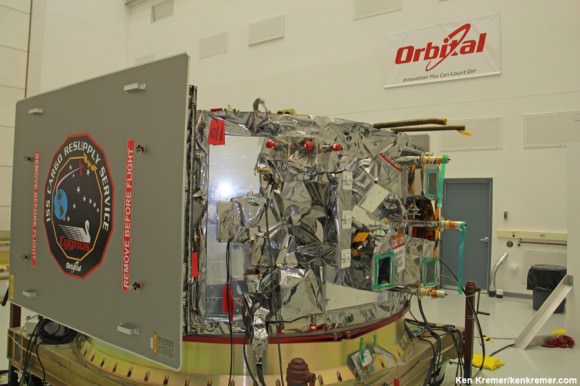
Science experiments weighing 1000 pounds account for nearly 1/3 of the cargo load.
Among those are 23 student designed experiments representing over 8700 K-12 students involving life sciences topics ranging from amoeba reproduction to calcium in the bones to salamanders.
The students are part of the Student SpaceFlight Experiments Program (SSEP) sponsored by the National Center for Earth and Space Science Education (NCESSE).
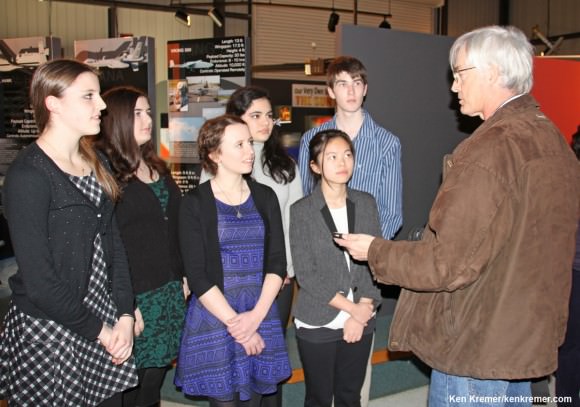
Ant colonies from three US states are also aboard, living inside 8 habitats. The “ants in space” experiment will be among the first to be unloaded from Cygnus to insure the critters are well fed for their expedition on how they fare and adapt in zero gravity.
33 cubesats are also aboard that will be deployed from the Japanese Experiment Module airlock.
“One newly arrived investigation will study the decreased effectiveness of antibiotics during spaceflight. Another will examine how different fuel samples burn in microgravity, which could inform future design for spacecraft materials,” said NASA in a statement.
Cygnus is currently scheduled to remain berthed at the ISS for 37 days until February 18.
The crew will reload it with all manner of no longer need trash and then send it off to a fiery and destructive atmospheric reentry so it will burn up high over the Pacific Ocean on Feb. 19.
Cygnus departure is required to make way for the next cargo freighter – the SpaceX Dragon, slated to blast off from Cape Canaveral, Florida on Feb. 22 atop the company’s upgraded Falcon 9.
Watch for my ongoing Antares/Cygnus reports.
Stay tuned here for Ken’s continuing Orbital Sciences, SpaceX, commercial space, Chang’e-3, LADEE, Mars and more news.
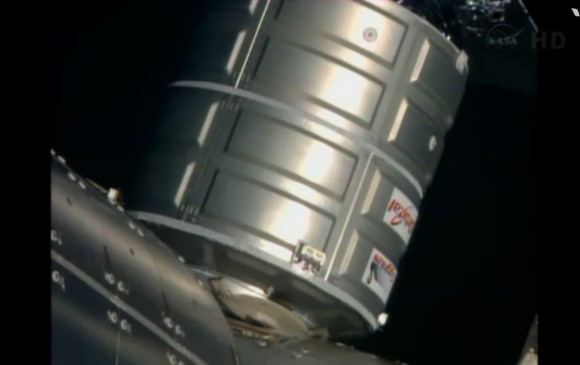

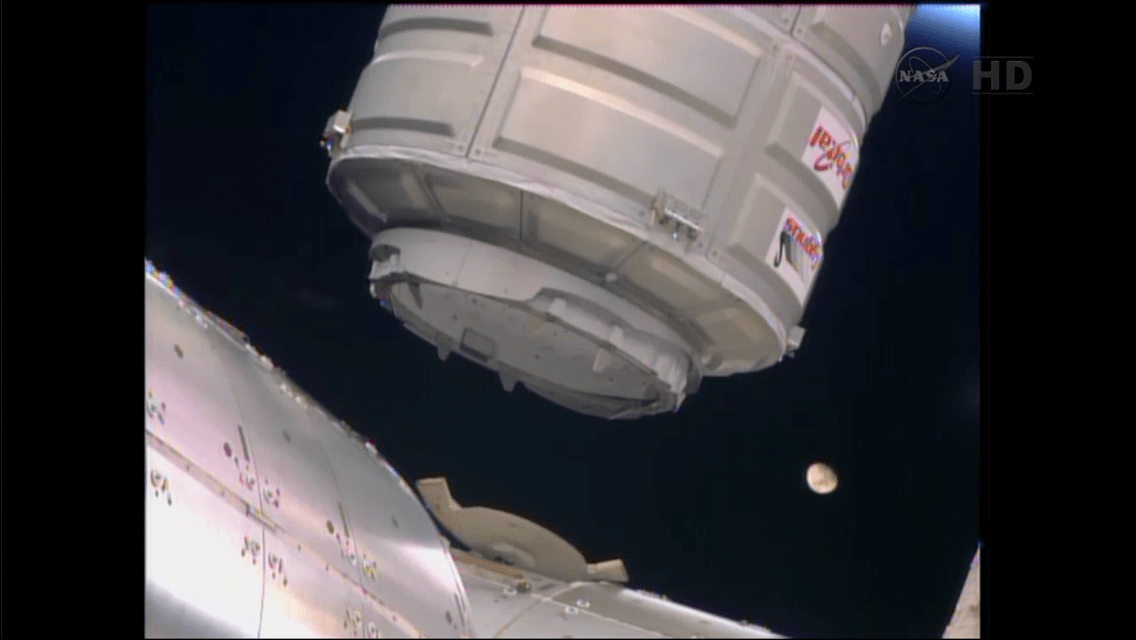
Typo: “e SpaceX Dragon, slated to blast off from Cape Canaveral, Florida on Feb. 22 atop the companies upgraded Falcon 9”
“companies” should be “company’s”.
fixed thanks
Well done…Will either Orbital or Space X fly the now standard(?) Russian style shortened flight profile to the ISS in future?
maybe – future story
I’m interested in that topic too, and I imagine others have been wondering about it as well, so I’m sure that would be a well received article.
Also, thanks for fixing that typo I mentioned below. And please don’t take offense when we point them out. In my case at least I’m just trying to help:). No insult intended.
Everyone needs editing. This way you’re just crowdsourcing it.